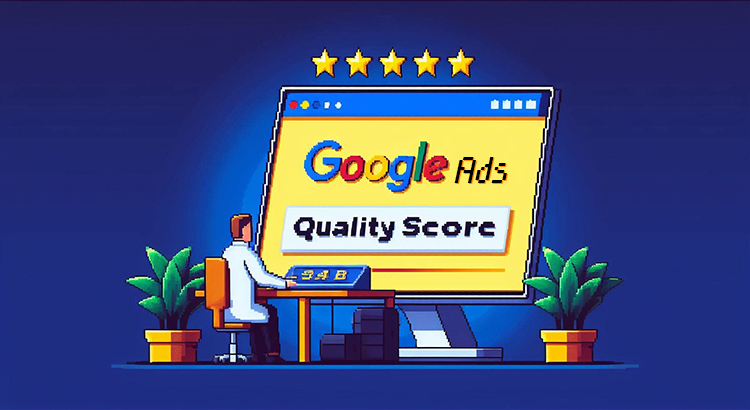Quality Score (QS) plays a crucial role in the success of your Google Ads campaign. It is a metric employed by Google to assess the relevance and quality of your advertisements. Understanding and improving Google Ads Quality Score can significantly enhance your ad’s performance and overall campaign success.
What Is Quality Score?
Quality Score is a numerical representation of how well your ad aligns with the needs and search intent of potential customers. Ranging from 1 to 10, a higher Quality Score indicates a more relevant and effective ad.
A higher Quality Score implies greater relevance compared to competitors, positively impacting ad performance. Essentially, Quality Score is a tool that guides advertisers in refining their ads, keywords, and landing pages for better campaign outcomes.
Related Article: Mastering Google Ads: A Comprehensive Guide for Beginners
How to Improve Quality Score in Google Ads?
1. Review Your Quality Score Components
To gain specific insights into areas for improvement, it’s essential to dive deeper into the three pivotal components of Quality Score. These components serve as valuable indicators of your ad’s overall effectiveness and relevance.
Here’s a breakdown of each component:
Expected CTR
Expected Click-Through Rate (CTR) is a metric that estimates how frequently users will click on your ad when their search query matches your target keyword.
Google utilizes historical data to predict this rate. A higher expected CTR signifies that Google believes your ad is more likely to be clicked, positively impacting your Quality Score.
Ad Relevance
Ad relevance measures the alignment between your ad’s target keyword and its content with what users are actively searching for.
If your ad is highly relevant to the user’s query, it not only increases your Quality Score but also enhances the likelihood of your ad being shown to users.
Landing Page Experience
Landing Page Experience assesses the quality of the page users land on after clicking your ad. Google considers factors such as page load speed, mobile friendliness, and content relevance to determine this experience.
A better landing page experience not only contributes to an improved Quality Score but also increases the likelihood of users taking the desired action.
Useful Article: Best Landing Page Builders for Enhanced Engagement
These components, evaluated with statuses like “Below average,” “Average,” and “Above average,” guide improvements in ad text, keywords, and landing pages.
Prioritize user needs, ensuring good performance. Utilize Quality Score as a diagnostic tool for continual enhancement and long-term performance goals.
2. Make Ads More Relevant to Keywords
Ad relevance is crucial for effective advertising. If your Ad relevance is “Below average” or “Average,” consider implementing these best practices:
- Align the language of your ad text more closely with user search terms.
- Identify ad groups with diverse keywords; split them into multiple groups for better alignment with user searches.
- Group keywords into themes based on products or services to enhance overall relevance, such as creating separate groups for “engagement rings” and “wedding bands” if you sell rings.
3. Try to Improve Your Clickthrough Rate (CTR)
Enhancing your Expected Clickthrough Rate (Exp. CTR) is vital for campaign success. If it’s “Below average” or “Average,” consider these best practices:
- Edit ad text for a more compelling offer to your target audience.
- Ensure ad details align with keyword intent.
- Highlight unique product/service benefits, like free shipping.
- Experiment with varied calls to action closely connected to your landing page.
- Craft compelling calls to action using words like “Buy,” “Sell,” “Order,” “Browse,” “Find,” “Sign up,” “Try,” and “Get a Quote.”
- Be more specific in your ad text.
Find the balance between specificity and conversion rates for optimal performance.
4. Consider Updating Your Landing Page
A compelling landing page is crucial for a successful online marketing strategy. If your Landing Page Experience (Landing page exp.) is “Below average” or “Average,” implement these best practices:
- Align the landing page content with user expectations to provide what they are searching for.
- Maintain consistency in messaging from the ad to the landing page, ensuring it fulfills the promised offer or call to action.
- Experiment to optimize existing pages if you lack control over the site’s content.
- Consider using conversion rate as a proxy for a positive landing page experience, although it doesn’t impact the landing page status directly.
- Prioritize mobile-friendliness for enhanced user experience, utilizing tools like the Mobile-Friendly Test.
- Improve loading speed, recognizing its impact on user engagement and potential conversions.
Related Article: Landing Page Best Practices for High Conversion Rates
5. Use Quality Score with Other Metrics
Integrate Quality Score analysis with additional metrics in your account, such as clickthrough rate, conversion rate, and site engagement. These metrics are interconnected and offer insights for targeted improvements. Employ Quality Score as a filter while reviewing performance:
- Examine high-performing keywords, using Quality Score to identify opportunities for enhancement through adjustments to ads and landing pages.
- Leverage low Quality Scores and component statuses to identify overarching trends in ad relevance, clickthrough rate, and landing page experience across your account. Establish long-term improvement plans based on these findings.
Conclusion of Google Ads Quality Score
Understanding and optimizing Google Ads Quality Score is crucial for the success of your Google Ads campaign. By following the methods mentioned in this article, advertisers can enhance their ad quality and relevance, ultimately improving campaign performance.


